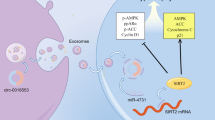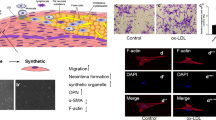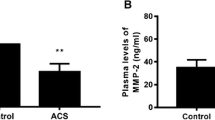Abstract
Cardiovascular disease (CVD) is a leading non-communicable disease with a high fatality rate worldwide. Hypertension, a common cardiovascular condition, is a significant risk factor for the development of heart failure because the activation of the renin-angiotensin system (RAS) is considered to be the major promoting reason behind myocardial fibrosis (MF). In this study, Angiotensin II (Ang II) stimulation-induced endothelial to mesenchymal transition (End-MT) in HCAECs, including the decrease of CD31 level, the increase of α-SMA, collagen I, slug, snail, and TGF-β1 levels, and the promotion of Smad2/3 phosphorylation. Meanwhile, the c-Ski level was reduced in Ang II-stimulated HCAECs. In HCAECs, Ang II-induced changes could be partially attenuated by c-Ski overexpression. miR-214-3p directly targeted c-Ski and inhibited c-Ski expression. Moreover, miR-214-3p inhibition reduced Ang II-caused End-MT in HCAECs. miR-214-3p overexpression further enhanced Ang II-induced End-MT, while c-Ski overexpression could markedly reverse the effects of miR-214-3p overexpression. In the Ang II-induced mouse cardiac hypertrophic model, Ang II-caused increase of cellular cross-sectional area and cardiac fibrosis were partially ameliorated by LV-c-Ski; when mice were co-treated with LV-c-Ski and agomir-214-3p, the beneficial effects of LV-c-Ski were reversed. In conclusion, the miR-214-3p/c-Ski axis modulated Ang II-induced End-MT in HCAECs and cardiac hypertrophy and fibrosis in the mice model.






Similar content being viewed by others
Data availability
All data and material are available.
References
Mendis S, Davis S, Norrving B. Organizational update: the world health organization global status report on noncommunicable diseases 2014; one more landmark step in the combat against stroke and vascular disease. Stroke. 2015;46(5):e121–2.
Shenasa M, Shenasa H. Hypertension, left ventricular hypertrophy, and sudden cardiac death. Int J Cardiol. 2017;237:60–3.
Conrad CH, et al. Myocardial fibrosis and stiffness with hypertrophy and heart failure in the spontaneously hypertensive rat. Circulation. 1995;91(1):161–70.
Sovari AA, Karagueuzian HS. Myocardial fibrosis as a risk stratifier for sudden arrhythmic death. Expert Rev Cardiovasc Ther. 2011;9(8):951–3.
Park S, et al. Cardiac fibrosis: potential therapeutic targets. Transl Res. 2019;209:121–37.
Leask A. Potential therapeutic targets for cardiac fibrosis: TGFbeta, angiotensin, endothelin, CCN2, and PDGF, partners in fibroblast activation. Circ Res. 2010;106(11):1675–80.
Bischoff J. Endothelial-to-mesenchymal transition. Circ Res. 2019;124(8):1163–5.
Li Y, Lui KO, Zhou B. Reassessing endothelial-to-mesenchymal transition in cardiovascular diseases. Nat Rev Cardiol. 2018;15(8):445–56.
Piera-Velazquez S, Jimenez SA. Endothelial to mesenchymal transition: role in physiology and in the pathogenesis of human diseases. Physiol Rev. 2019;99(2):1281–324.
Zeisberg EM, et al. Endothelial-to-mesenchymal transition contributes to cardiac fibrosis. Nat Med. 2007;13(8):952–61.
Zeisberg EM, et al. Fibroblasts in kidney fibrosis emerge via endothelial-to-mesenchymal transition. J Am Soc Nephrol. 2008;19(12):2282–7.
Xu X, et al. Snail is a direct target of hypoxia-inducible factor 1alpha (HIF1alpha) in hypoxia-induced endothelial to mesenchymal transition of human coronary endothelial cells. J Biol Chem. 2015;290(27):16653–64.
Cunnington RH, et al. Antifibrotic properties of c-Ski and its regulation of cardiac myofibroblast phenotype and contractility. Am J Physiol Cell Physiol. 2011;300(1):C176–86.
Cunnington RH, et al. The Ski-Zeb2-Meox2 pathway provides a novel mechanism for regulation of the cardiac myofibroblast phenotype. J Cell Sci. 2014;127(Pt 1):40–9.
Wang J, et al. The mechanism of TGF-beta/miR-155/c-Ski regulates endothelial–mesenchymal transition in human coronary artery endothelial cells. Biosci Rep. 2017;37(4):BSR20160603.
Lucas T, Bonauer A, Dimmeler S. RNA therapeutics in cardiovascular disease. Circ Res. 2018;123(2):205–20.
Liang H, et al. A novel reciprocal loop between microRNA-21 and TGFbetaRIII is involved in cardiac fibrosis. Int J Biochem Cell Biol. 2012;44(12):2152–60.
Abonnenc M, et al. Extracellular matrix secretion by cardiac fibroblasts: role of microRNA-29b and microRNA-30c. Circ Res. 2013;113(10):1138–47.
Wang BW, et al. MicroRNA-208a increases myocardial fibrosis via endoglin in volume overloading heart. PLoS ONE. 2014;9(1): e84188.
Beaumont J, et al. microRNA-122 down-regulation may play a role in severe myocardial fibrosis in human aortic stenosis through TGF-beta1 up-regulation. Clin Sci (Lond). 2014;126(7):497–506.
Savary G, et al. MiR-214-3p, a new fibromiR involved in the pathogenesis of idiopathic pulmonary fibrosis. Eur Respir J. 2014;44(Suppl 58):1731.
Zhao Y, et al. The role of miR-214 in cardiovascular diseases. Eur J Pharmacol. 2017;816:138–45.
Liu H, et al. LncRNA XIST/miR-34a axis modulates the cell proliferation and tumor growth of thyroid cancer through MET-PI3K-AKT signaling. J Exp Clin Cancer Res. 2018;37(1):279.
Song J, et al. Pellino1-mediated TGF-beta1 synthesis contributes to mechanical stress induced cardiac fibroblast activation. J Mol Cell Cardiol. 2015;79:145–56.
Wang J, et al. The ACE2-Ang (1–7)-Mas receptor axis attenuates cardiac remodeling and fibrosis in post-myocardial infarction. Mol Med Rep. 2017;16(2):1973–81.
Baker KM, Aceto JF. Angiotensin II stimulation of protein synthesis and cell growth in chick heart cells. Am J Physiol. 1990;259(2 Pt 2):H610–8.
Mehta PK, Griendling KK. Angiotensin II cell signaling: physiological and pathological effects in the cardiovascular system. Am J Physiol Cell Physiol. 2007;292(1):C82–97.
Li D, et al. Modulation of constitutive nitric oxide synthase, bcl-2 and Fas expression in cultured human coronary endothelial cells exposed to anoxia-reoxygenation and angiotensin II: role of AT1 receptor activation. Cardiovasc Res. 1999;41(1):109–15.
You S, et al. Schizandrin B attenuates angiotensin II induced endothelial to mesenchymal transition in vascular endothelium by suppressing NF-kappaB activation. Phytomedicine. 2019;62:152955.
Liu L, et al. Angiotensin II inhibits the protein expression of ZO1 in vascular endothelial cells by downregulating VE cadherin. Mol Med Rep. 2018;18(1):429–34.
Flynt AS, et al. Zebrafish miR-214 modulates Hedgehog signaling to specify muscle cell fate. Nat Genet. 2007;39(2):259–63.
Juan AH, et al. Mir-214-dependent regulation of the polycomb protein Ezh2 in skeletal muscle and embryonic stem cells. Mol Cell. 2009;36(1):61–74.
Penna E, et al. microRNA-214 contributes to melanoma tumour progression through suppression of TFAP2C. EMBO J. 2011;30(10):1990–2007.
Li D, et al. Osteoclast-derived exosomal miR-214-3p inhibits osteoblastic bone formation. Nat Commun. 2016;7:10872.
van Mil A, et al. MicroRNA-214 inhibits angiogenesis by targeting quaking and reducing angiogenic growth factor release. Cardiovasc Res. 2012;93(4):655–65.
van Balkom BW, et al. Endothelial cells require miR-214 to secrete exosomes that suppress senescence and induce angiogenesis in human and mouse endothelial cells. Blood. 2013;121(19):3997–4006.
Denby L, et al. MicroRNA-214 antagonism protects against renal fibrosis. J Am Soc Nephrol. 2014;25(1):65–80.
Aurora AB, et al. MicroRNA-214 protects the mouse heart from ischemic injury by controlling Ca(2)(+) overload and cell death. J Clin Invest. 2012;122(4):1222–32.
Liu Y, et al. MicroRNA-214-3p in the kidney contributes to the development of hypertension. J Am Soc Nephrol. 2018;29(10):2518–28.
Colson P, Ryckwaert F, Coriat P. Renin angiotensin system antagonists and anesthesia. Anesth Analg. 1999;89(5):1143–55.
Sata M, Fukuda D. Crucial role of renin-angiotensin system in the pathogenesis of atherosclerosis. J Med Invest. 2010;57(1–2):12–25.
Palomeque J, Delbridge L, Petroff MV. Angiotensin II: a regulator of cardiomyocyte function and survival. Front Biosci (Landmark Ed). 2009;14:5118–33.
Wang L, et al. CXCL1-CXCR2 axis mediates angiotensin II-induced cardiac hypertrophy and remodelling through regulation of monocyte infiltration. Eur Heart J. 2018;39(20):1818–31.
Ye S, et al. Celastrol attenuates angiotensin II-induced cardiac remodeling by targeting STAT3. Circ Res. 2020;126(8):1007–23.
Luo YX, et al. SIRT4 accelerates Ang II-induced pathological cardiac hypertrophy by inhibiting manganese superoxide dismutase activity. Eur Heart J. 2017;38(18):1389–98.
Acknowledgements
This study was supported by Xinjiang Science and Technology Support Project (2018E02064).
Funding
This study was supported by Xinjiang Science and Technology Support Project (2018E02064).
Author information
Authors and Affiliations
Contributions
JW and HL conception and design the experiments. JW drafting the article. HL revising the article critically for important intellectual content. WD contributed to the conception of the study. ZL, XL, TZ and YZ contributed to cell and animal experiments. WS and XW contributed to the analysis and manuscript preparation. All the authors read and approved the manuscript.
Corresponding author
Ethics declarations
Conflict of interest
All authors declare that they have no conflicts of interest in this work.
Ethics approval
All animal experiments were approved by the Animal Ethics Committee of The Fifth Affiliated Hospital of Xinjiang Medical University.
Additional information
Publisher's Note
Springer Nature remains neutral with regard to jurisdictional claims in published maps and institutional affiliations.
Supplementary Information
Below is the link to the electronic supplementary material.
Fig.S1
The expression of c-Ski, α-SMA, and collagen I in response to the treatment of Ang II of different concentrations (0, 1, 2.5, 5, and 10 μg/ml) for 24 h in HCAECs.. n=3; **P<0.01.Supplementary file 3 (TIF 333 KB)
Fig.S2
The predicted binding site between miR-124-3p and 3'UTR of c-Ski in rat and mouse species. Supplementary file 4 (TIF 203 KB)
Rights and permissions
About this article
Cite this article
Wang, J., Li, H., Lv, Z. et al. The miR-214-3p/c-Ski axis modulates endothelial–mesenchymal transition in human coronary artery endothelial cells in vitro and in mice model in vivo. Human Cell 35, 486–497 (2022). https://doi.org/10.1007/s13577-021-00653-6
Received:
Accepted:
Published:
Issue Date:
DOI: https://doi.org/10.1007/s13577-021-00653-6




